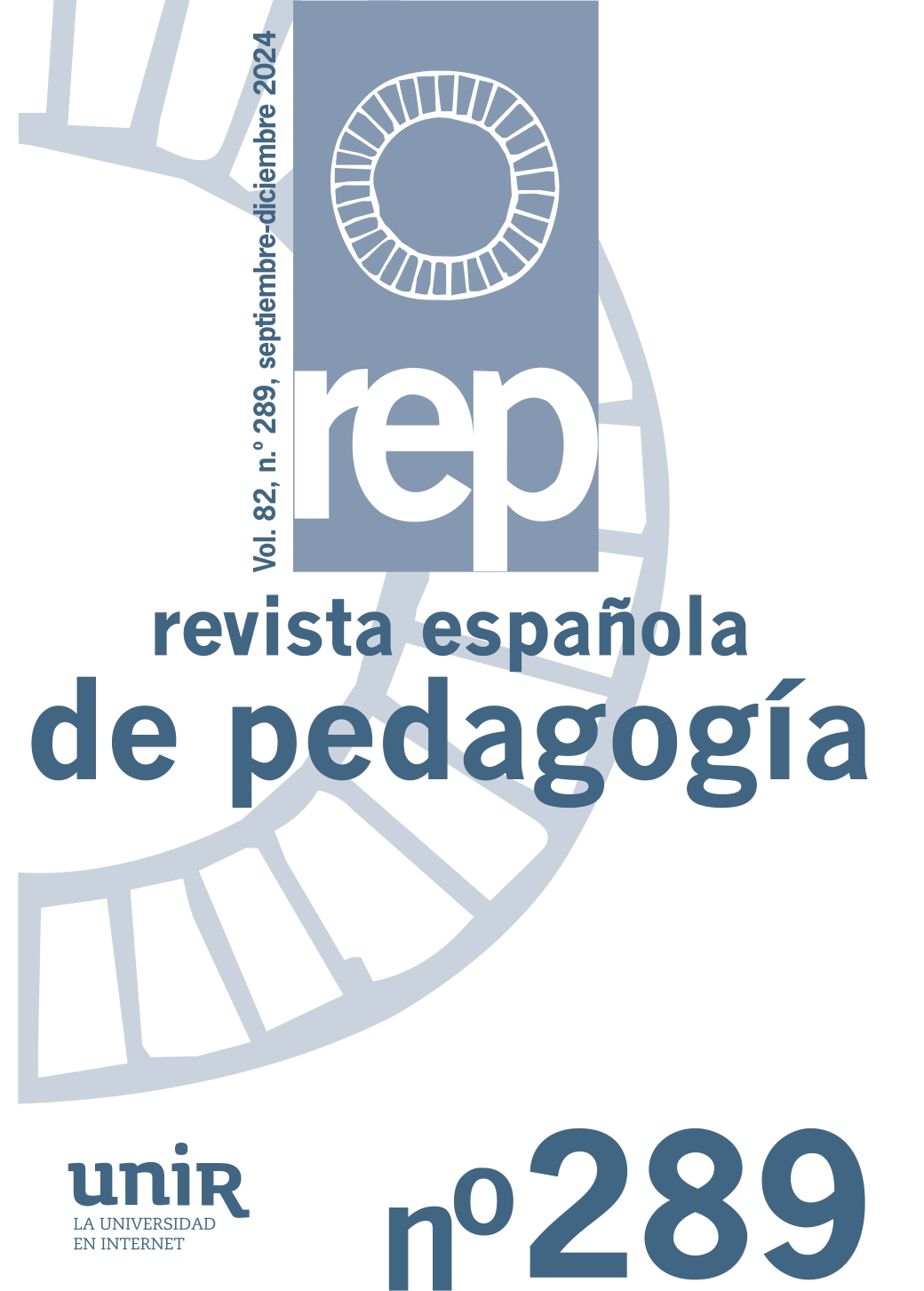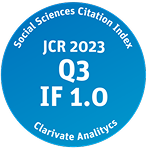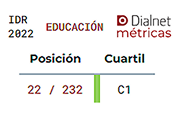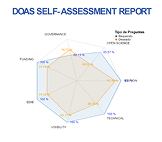The impact of linguistic immersion and economic, social and cultural status on academic performance.
DOI:
https://doi.org/10.22550/2174-0909.4178Keywords:
immersion programs, academic achievement, educational equity, educational policy, educational assessment, structural equations modellingAbstract
The linguistic issue in the schools presents in Spain an educational dimension of considerable social interest, since a strong immersive process in the regional language could be affecting the performance of students, depending on their linguistic and socio-cultural background. In this context, the main objective of this paper is to analyse the relations between economic, social and cultural status (ESCS); percentage of students who speak a language different from their home (language); and school performance in PISA (performance). And measure the predictive power of the second variable with respect to the third, from a territorial perspective. A methodology has been developed based on bivariate linear regression analysis and on structural equations modelling, applied on data of these three variables available in PISA 2015 and PISA 2022. These secondary analyses have confirmed: a) the importance of the predictive power of the ESCS on performance in a consistent manner, both in 2015 and 2022; b) the intensification of the association between the two variables in that period; and c) the emergence of a moderate but significant association of the language variable as a predictor of performance at the territorial level. The impact of territorial differences in ESCS on performance has increased significantly between 2015 and 2022, which is compatible with the increase of other territorial divides described in the literature. On the other hand, the models of a strong linguistic immersion mark significant differences between territories, in terms of performance. For example, for this reason alone, Catalonia's delay compared to Madrid is approximately one school year.
Downloads
References
Bacher-Hicks, A., Goodman, J., y Mulhern, C. (2021). Inequality in household adaptation to schooling shocks: Covid-induced online learning engagement in real time [Desigualdad en la adaptación de los hogares a las crisis escolares: participación en el aprendizaje en línea inducida por covid en tiempo real]. Journal of Public Economics, 193, 104345. https://doi.org/10.1016/j.jpubeco.2020.104345
Ball, J. (2011). Enhancing learning of children from diverse language backgrounds: Mother tongue-based bilingual or multilingual education in the early years [Mejorar el aprendizaje de los niños de diversos orígenes lingüísticos: educación bilingüe o plurilingüe basada en la lengua materna en los primeros años]. United Nations Educational, Scientific and Cultural Organization (UNESCO). https://unesdoc.unesco.org/ark:/48223/pf0000212270
Benson, C. (2004). The importance of mother tongue-based schooling for educational quality [La importancia de la escolarización basada en la lengua materna para la calidad de la educación]. United Nations Educational, Scientific and Cultural Organization (UNESCO). https://unesdoc.unesco.org/ark:/48223/pf0000146632
Bialystok, E., Craik, F. I., y Luk, G. (2012). Bilingualism: Consequences for mind and brain [Bilingüismo: consecuencias para la mente y el cerebro]. Trends in Cognitive Sciences, 16 (4), 240-250.
Bryman, A., y Cramer, D. (1994). Quantitative data analysis for social scientists [Análisis cuantitativo de datos para científicos sociales]. Routledge.
Bühmann, D., y Trudell, B. (2007). Mother tongue matters: Local language as a key to effective learning [La lengua materna importa: la lengua local como clave para un aprendizaje eficaz]. United Nations Educational, Scientific and Cultural Organization (UNESCO). https://unesdoc.unesco.org/ark:/48223/pf0000161121
Bulut, O., Delen, E., y Kaya, F. (2012). An SEM model based on PISA 2009 in Turkey: How does the use of technology and self-regulation activities predict reading scores? [Un modelo SEM basado en PISA 2009 en Turquía: ¿cómo predice el uso de la tecnología y las actividades de autorregulación las puntuaciones de lectura?]. Procedia - Social and Behavioral Sciences, 64, 564- 573. https://doi.org/10.1016/j.sbspro.2012.11.066
Calero, J., y Choi, Á. (2019). Efectos de la inmersión lingüística sobre el alumnado castellanoparlante en Cataluña. Fundación Europea Sociedad y Educación. https://sociedadyeducacion.org/site/wp-content/uploads/SE-Inmersion-Cataluna.pdf
Carabaña, J., y Fernández-Enguita, M. (2019). Enseñanza en lenguas regionales y sentimiento de pertenencia a la escuela. Journal of Supranational Policies of Education, (9), 57-94. http://doi.org/10.15366/jospoe2019.9.002
Castro, M., y Egido, I. (2024). Qué sabemos sobre el profesorado. Políticas, evidencias y perspectivas de futuro. Narcea.
Chetty, R., Friedman, J. N., Hendren, N., y Stepner, M. (2020). How did covid-19 and stabilization policies affect spending and employment? A new real-time economic tracker based on private sector data [¿Cómo afectaron el covid-19 y las políticas de estabilización al gasto y al empleo? Un nuevo rastreador económico en tiempo real basado en datos del sector privado]. NBER Working Paper, (27431). https://doi.org/10.3386/w27431
Clots-Figueras, I., y Masella, P. (2013). Education, language and identity [Educación, lenguaje e identidad]. The Economic Journal, 123 (570), 332-357.
Cummins, J. (2001). Bilingual children’s mother tongue: Why is it important for education? [Lengua materna de los niños bilingües: ¿Por qué es importante para la educación]. Sprogforum, 7 (19),15-20.
Epskamp S., Stuber S., Nak J., Veenman M., y Jorgensen T.D. (2019). semPlot: Path diagrams and visual analysis of various SEM packages’ output [semPlot: diagramas de camino y análisis visual de la salida de varios paquetes SEM][Software]. https://CRAN.R-project.org/package=semPlot
Foguet, J. M. B., y Gallart, G. C. (2000). Modelos de ecuaciones estructurales. La Muralla.
Gairín, J. (2024). Dirección y liderazgo de los centros educativos. Naturaleza, desarrollo y práctica profesional. Narcea.
Gallucci, M., y Jentschke, S. (2021). SEMLj: jamovi SEM Analysis [Software]. https://semlj.github.io/
Hattie, J. (2023). Visible learning: The sequel. A synthesis of over 2,100 meta-analyses relating to achievement [Aprendizaje visible: la secuela. Una síntesis de más de 2100 metaanálisis relacionados con el rendimiento]. Routledge.
Hovens, M. (2002). Bilingual education in West Africa: Does it work? [Educación bilingüe en África Occidental: ¿funciona?]. International Journal of Bilingual Education and Bilingualism, 5 (5), 249-266.
Kim, J. O., y Kohout, F. J. (1988). Special topics in general linear models [Temas especiales en modelos lineales generales]. En N. H. Nie, D. H. Bent, y C. H. Hull, Statistical package for the social sciences [Paquete estadístico para las ciencias sociales]. McGraw- Hill.
López-Rupérez, F., García-García, I., y Expósito Casas E. (2018). PISA 2015 y las comunidades autónomas españolas. Diagnósticos y políticas de mejora. Universidad Camilo José Cela. https://www.ucjc.edu/pdfs/universidad/pisa2015_ccaa.pdf
López-Rupérez, F., García-García, I., y Expósito-Casas, E. (2019a). Rendimiento en ciencias, concepciones epistémicas y vocaciones STEM en las comunidades autónomas españolas. Evidencias desde PISA 2015, políticas y prácticas de mejora. Revista Española de Pedagogía, 272 (77), 5-27. https://doi.org/10.22550/REP77-1-2019-09
López-Rupérez, F., García-García, I., y Expósito-Casas, E. (2019b). Educational effectiveness, efficiency, and equity in Spanish regions: What does PISA 2015 reveal? [Eficacia, eficiencia y equidad educativas en las regiones españolas: ¿Qué revela PISA 2015?]. ORBIS SCHOLAE, 12 (2), 9-36. https://doi.org/10.14712/23363177.2018.291
López-Rupérez, F., García-García, I., y Expósito-Casas, E. (2019c). Igualdad de oportunidades e inclusión educativa en España. RELIEVE, 25 (2), 1. http://doi.org/10.7203/relieve.25.2.14351
López-Rupérez, F., García-García, I., y Expósito-Casas, E. (2021). La repetición de curso y la graduación en Educación Secundaria Obligatoria en España: análisis empíricos y recomendaciones políticas. Revista de Educación, 394, 325-354. https://doi.org/10.4438/1988-592X-RE-2021-394-510
López-Rupérez, F., y García-García, I. (2023, 11 de diciembre). PISA 2022 y la cuestión territorial en España. Magisnet. https://www.magisnet.com/2023/12/pisa-2022-y-la-cuestion-territorial-en-espana/
OECD (2016). PISA 2015 results (volume I). Excellence and equity in education [Resultados PISA 2015 (volumen I). Excelencia y equidad en la educación].
OECD Publishing. https://doi. org/10.1787/9789264266490-en OECD (2023). PISA 2022 results (volume I). The state of learning and equity in education [Resultados PISA 2022 (volumen I). El estado del aprendizaje y la equidad en la educación]. OECD Publishing. https://doi.org/10.1787/53f23881-en
Parliamentary Assembly. (2006). The place of mother tongue in school education [El lugar de la lengua maternal en la educación escolar] (Doc. 10837). Committee on Culture, Science and Education. Council of Europe. https://assembly.coe.int/nw/xml/XRef/X2H-Xref-ViewHTML.asp?FileID=11142&lang=EN
Pearl, J., y Mackenzie, D. (2020). El libro del porqué. La nueva ciencia de la causa y el efecto. Pasado y Presente.
Pérez, E., Medrano, L. A., y Sánchez-Rosas, J. (2013). El path analysis: conceptos básicos y ejemplos de aplicación. Revista Argentina de Ciencias del Comportamiento, 5 (1), 52-66.
Pinnock, H. (2009a). Language and education. The missing link. How the language used in schools threatens the achievement of education for all [Lenguaje y educación. El eslabón perdido. Cómo el lenguaje utilizado en las escuelas amenaza el logro de la educación para todos]. CfBT Education Trust & Save the Children. https://resourcecentre.savethechildren.net/pdf/1674.pdf/
Pinnock, H. (2009b). Steps towards learning: A guide to overcoming language barriers in children´s education [Pasos hacia el aprendizaje: una guía para superar las barreras lingüísticas en la educación de los niños]. Save the Children.
https://www.savethechildren.org.uk/content/dam/global/reports/steps-towards-learning-lr.pdf
Reilly, C. (2019). Language and development: Issues in mother tongue based multilingual education [Lenguaje y desarrollo: problemas en la educación multilingüe basada en la lengua materna ] [Documento Inédito]. https://www.researchgate.net/publication/343768795_Language_and_development_Issues_in_mother-tongue_based_multilingual_education#fullTextFileContent
Rodríguez, P. (2023, 7 de diciembre). Catalunya se pregunta por qué se ha hundido más que el resto de España en PISA. Eldiario.es. https://www.eldiario.es/catalunya/catalunya-pregunta-hundido-resto-espana-pisa_1_10748162.html
Rodríguez-Sanmartín, O. (2023, 19 de diciembre). Los alumnos de Cataluña son los que muestran el mayor rechazo a la escuela de toda España. El Mundo. https://www.elmundo.es/espana/2023/12/19/6581fb22fdddff570d8b45b5.html
Rosseel, Y. (2012). Iavaan: An R package for structural equation modeling [Iavaan: un paquete de R para la modelización de ecuaciones estructurales]. Journal of Statistical Software, 48 (2), 1-36. https://doi.org/10.18637/jss.v048.i02
Salas, A. A., Navarro, R., y Montero, E. (2017). Un modelo de ecuaciones estructurales para el estudio de factores que afectan la competencia lectora y la alfabetización matemática: una aproximación bayesiana con datos de PISA 2009. Estadística Española, 59 (194), 167-192.
Sanz, I., y Tena, J.D. (2023). The impact of the covid-19 pandemic on education learning [El impacto de la pandemia de covid-19 en el aprendizaje educativo]. En J. Sanz, e I. Sanz (Eds.), Addressing inequities in modern educational assessment [Hacer frente a las desigualdades en la evaluación educativa moderna] (pp. 15- 36). Springer. https://doi.org/10.1007/978-3- 031-45802-6_2
Schermelleh-Engel, K., Moosbrugger, H., y Müller, H. (2003). Evaluating the fit of structural equation models: Tests of significance and descriptive goodness-of-fit measures [Evaluación del ajuste de los modelos de ecuaciones estructurales: pruebas de significación y medidas descriptivas de bondad de ajuste]. Methods of Psychological Research, 8 (2), 23-74.
Soler, A. (2022). Heterogeneidad regional en el abandono educativo temprano. Magisterio, 24- 25.
Swe, K.M., Fraser, B. J., y Afari, E. (2020). Structural relationships between learning environments and students’ non-cognitive outcomes: Secondary analysis of PISA data [Relaciones estructurales entre los entornos de aprendizaje y los resultados no cognitivos de los estudiantes: análisis secundario de los datos de PISA]. Learning Environments Research, 23 (3), 395-412. https://doi.org/10.1007/s10984-020-09313-2
The jamovi project. (2022). jamovi (version 2.3) [Software]. https://www.jamovi.org
Thomas, W. P., y Collier, V. P. (1997). School effectiveness for language minority students [Eficacia escolar para estudiantes de minorías lingüísticas]. National Clearinghouse for Bilingual Education. https://ncela.ed.gov/sites/default/files/legacy/files/rcd/BE020890/School_effectiveness_for_langu.pdf
Thomas, W. P., y Collier, V. P. (2002). A national study of school effectiveness for language minority students’ long-term academic achievement [Un estudio nacional sobre la eficacia de las escuelas para el logro académico a largo plazo de los estudiantes de minorías lingüísticas]. Center for Research on Education, Diversity and Excellence. https://escholarship.org/uc/item/65j213pt
UNESCO. (1953). The use of the vernacular languages in education [El uso de lenguas vernáculas en educación]. Organización de las Naciones Unidas para la Educación, la Ciencia y la Cultura (UNESCO).
UNESCO (2016). Si no entiendes, ¿cómo puedes aprender? Informe de seguimiento de la educación en el mundo. Organización de las Naciones Unidas para la Educación, la Ciencia y la Cultura (UNESCO). https://unesdoc.unesco.org/ark:/48223/pf0000243713_spa
UNESCO-IIEP (2021, 23 de septiembre). La lengua de enseñanza. https://bit.ly/3UsQE2C
Woessmann, L., Freundl, V., Grewenig, E., Lergetporer, P., Werner, K., y Zierow, L. (2020). Bildung in der Coronakrise: Wie haben die Schulkinder die Zeit der Schulschließungen verbracht, und welche Bildungsmaßnahmen befürworten die Deutschen? [La educación en la crisis del coronavirus: ¿Cómo pasaron los escolares el tiempo que las escuelas estuvieron cerradas y qué medidas educativas defienden los alemanes?]. ifo Schnelldienst, 9, 25-39
Downloads
Published
-
Abstract273
-
PDF (Español)65
-
PDF90
How to Cite
Issue
Section
License

This work is licensed under a Creative Commons Attribution-NonCommercial 4.0 International License.

